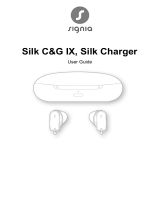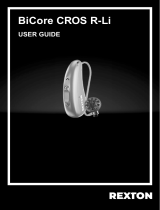Page is loading ...

ampli-cros I 5w RSTD
User Guide

2
Content
Welcome 4
Your CROS transmitter 5
Components and names 7
Hearing programs 9
Daily use 10
Charging 10
Turning on and o 11
Switching to andby mode 12
Inserting and removing the CROS transmitter 13
Changing the hearing program 17
Frequently asked queions 18
Maintenance and care 20
Ear pieces 23
Professional maintenance 26

3
Further information 27
Accessories 27
Explanation of symbols 27
Operating, transport and orage conditions 29
Disposal information 31
Troubleshooting 32
Conformance information 33
Country-specic information 35
Important safety information 36
Lithium-ion rechargeable battery (power cell) 36
Personal safety 39
Product safety 44
Service and warranty 47

4
Welcome
Thank you for choosing one of our hearing aid accessories.
This guide, along with support from your Hearing Care
Professional, will help you underand the advantages and
greater quality of life this accessory oers.
CAUTION
It is important to read this user guide thoroughly and
completely. Follow the safety information to avoid
damage or injury.
It is also important to read and follow the user guide
and safety manual for the hearing aid you use with
this accessory.

5
Your CROS transmitter
CROS solutions are designed for people with profound
hearing loss in one ear which can not be aided with a
hearing aid. A CROS transmitter worn on this ear captures
sound from this side and transmits it to the hearing aid on
the other ear. This allows the wearer of the hearing aid to
hear sounds from both sides.
CROS transmitter hearing aid

6
Two solutions are available:
zCROS solution:
For people with normal hearing in one ear and profound
hearing loss in the other. Sounds from the side with
hearing loss are captured and transmitted wirelessly to
the good-hearing side.
zBiCROS solution:
For people with profound hearing loss in one ear and less
severe hearing loss in the other. Sounds from the more
severe hearing loss side are captured and transmitted
wirelessly to the better-hearing side. The hearing aid
processes and amplies the sounds from both sides.
The CROS transmitter works with our specic wireless
hearing aids. Your Hearing Care Professional will advise
you on the compatible models.
NOTICE
This user guide only applies to the CROS transmitter.
Your hearing aid has a separate user guide.

7
Components and names
➋
➋
➋
➊Ear piece
➋Microphone opening
➌Charging contacts
➍Side indicator
(R = right ear,
L = left ear)
➎Removal cord

8
You can use the following andard ear piece:
Standard ear pieces Size
Sleeve 3.0 Vented/Closed/Power
Eartip 3.0 Open (optional)
Eartip 3.0 Tulip (optional)
You can easily exchange the andard ear pieces. Read
more in section "Maintenance and care".
Cuom-made ear pieces
Earmold 3.0

9
Hearing programs
1
2
3
4
5
6
Read more in section "Changing the hearing program".
Signal tones
Signal tones of the CROS transmitter – like a low battery
beep – are sent to the hearing aid.
Ask your Hearing Care Professional to congure the signal
tones.

10
Daily use
Charging
Use IF CIC Travel Charger to charge your CROS
transmitter. Follow the inructions in the charger's user
guide, where you will also nd useful tips on charging.
Place your CROS transmitter in the charger as shown:

11
Turning on and o
You have the following options to turn your device on or o.
XTurning on: Take the device out of the charger.
The artup melody is played in your hearing aid. The
default volume and hearing program are set.
XTurning o: Place the device in the charger.
Note that the charger mu be on.

12
Switching to andby mode
Via remote control, you can switch your device to andby
mode. This mutes the device. When you leave andby
mode, the previously used volume and hearing program
are set.
Note:
zIn andby mode, the device is not turned o completely.
It draws some power.
Therefore we recommend to use andby mode only for a
short period of time.
zIf you want to leave andby mode, but the remote control
or app is not at hand: Turn your device o and on again
(by shortly placing it in the charger until the green LED
lights up). In this case, the default volume and hearing
program are set.

13
Inserting and removing the CROS transmitter
CAUTION
Risk of injury!
XAlways wear the device with an ear piece.
XMake sure that the ear piece is completely
attached.
Inserting:
XIdentify right and left device so that you insert it in the
correct ear. The labeling or the color of the device
indicates the side:
red color, imprinted "R" = right ear
blue color, imprinted "L" = left ear

14
XTake care that the flap of the Sleeve matches the line
printed on the device.
XHold the device correctly before inserting it: Pay special
attention to the removal cord indicating the bottom.
The arrow which is printed on the device has to point
upwards.

15
XCarefully push the device
into the ear canal.
XTwi it slightly until it sits well.
Open and close your mouth to avoid
accumulation of air in the ear canal.

16
CAUTION
Risk of injury!
XInsert the ear piece carefully and not too deeply
into the ear.
zIt may be helpful to insert the right device with the
right hand and the left device with the left hand.
zIf you have problems inserting the device, use the
other hand to gently pull your earlobe downwards.
This opens the ear canal and eases insertion of the
device.
Removing:
XPush lightly on the back of your ear to loosen the device.
XRemove the device by pulling the removal cord towards
the back of your head.

17
CAUTION
Risk of injury!
XIn very rare cases the ear piece could remain
in your ear when removing the device. If this
happens, have the ear piece removed by a medical
professional.
Clean and dry your device after usage. Read more in
section "Maintenance and care".
Changing the hearing program
Depending on the liening situation, your device
automatically adju their sound.
Your device may also have several hearing programs which
allow you to change the sound, if needed. An optional signal
tone can indicate the program change.
XTo change the hearing program, refer to section "Hearing
programs" for a li of your hearing programs.
The default volume is applied.

18
Frequently asked queions
You may have some queions on how to be charge your
device. Read the queions and answers below. If you have
more queions, your Hearing Care Professional will help you.
"Why does my device not turn on when I take it out
of the charger?
Check the following:
zThe charger is o. Press and hold the button for
5 seconds to turn on the charger. Refer to the section
"Turning the charger on or o".
zThe charger's internal battery is too low. Connect the
charger to an electrical outlet.
Now take your device out of the charger.
"How can I turn o my device without charging it?
XPlace the device in the charger. Ensure that it is
inserted correctly (atus LEDs light up). The device is
automatically turned o and art charging.

19
X
Disconnect the charger from the electrical outlet.
XPress and hold the button for 5 seconds to turn o the
charger. Charging ops.
"What should I pay attention to when charging?
The device and charger mu be clean and dry. Observe the
operation conditions in section "Operating, transport, and
orage conditions". Avoid charging at high temperatures, as
this can shorten the life span and capacity of the power cell.
If you use the charger in a very warm environment, note
that it will op charging if the device or the charger's
temperature exceeds 42 °C (107 °F). The LED of the device
and/or of the charger LED will pulsate orange during the
cooling phase. Charging resumes automatically after the
device has cooled down. Do not touch the device until the
front LEDs are pulsing green, the device may be hot.

20
Maintenance and care
To prevent damage it is important that you take care of your
device and follow a few basic rules, which will soon become
a part of your daily routine.
Cleaning
Your device has protective coating. However, if not cleaned
regularly you may damage the device or cause personal
injury.
XClean your device daily with a soft, dry tissue.
XNever use running water or immerse the
device in water.
XNever apply pressure while cleaning.
XDo not use alcoholic solvent on the charging contact.
XTo avoid corrosion, use a soft and dry tissue to wipe o
sweat or liquid from the charging contact or device before
inserting this in the charger.
XAsk your Hearing Care Professional for recommended
cleaning products, special care sets, or more information
on how to keep your device in good condition.
/


















